The Kabbalah, the Tarot and the Middle Way
Kenneth Chan
3. An Overview of the Map
[Author’s note: This chapter provides a map of the spiritual quest and outlines how the different paths within the map interact. However, it is not necessary for the reader to fully comprehend all these interactions before reading the subsequent chapters. The subsequent chapters will explain what each path represents, and an understanding of this will help to clarify how they interact.]
The Tree of Life is a mystical journey. It is an adventure into realms of experiences yet unknown, but ever beckoning. It is the ultimate in the realization of our potential, the road to the ultimate healing. Yet it is a path already within us, like a dream waiting to be born, waiting to be revealed. If we would but only open the door.
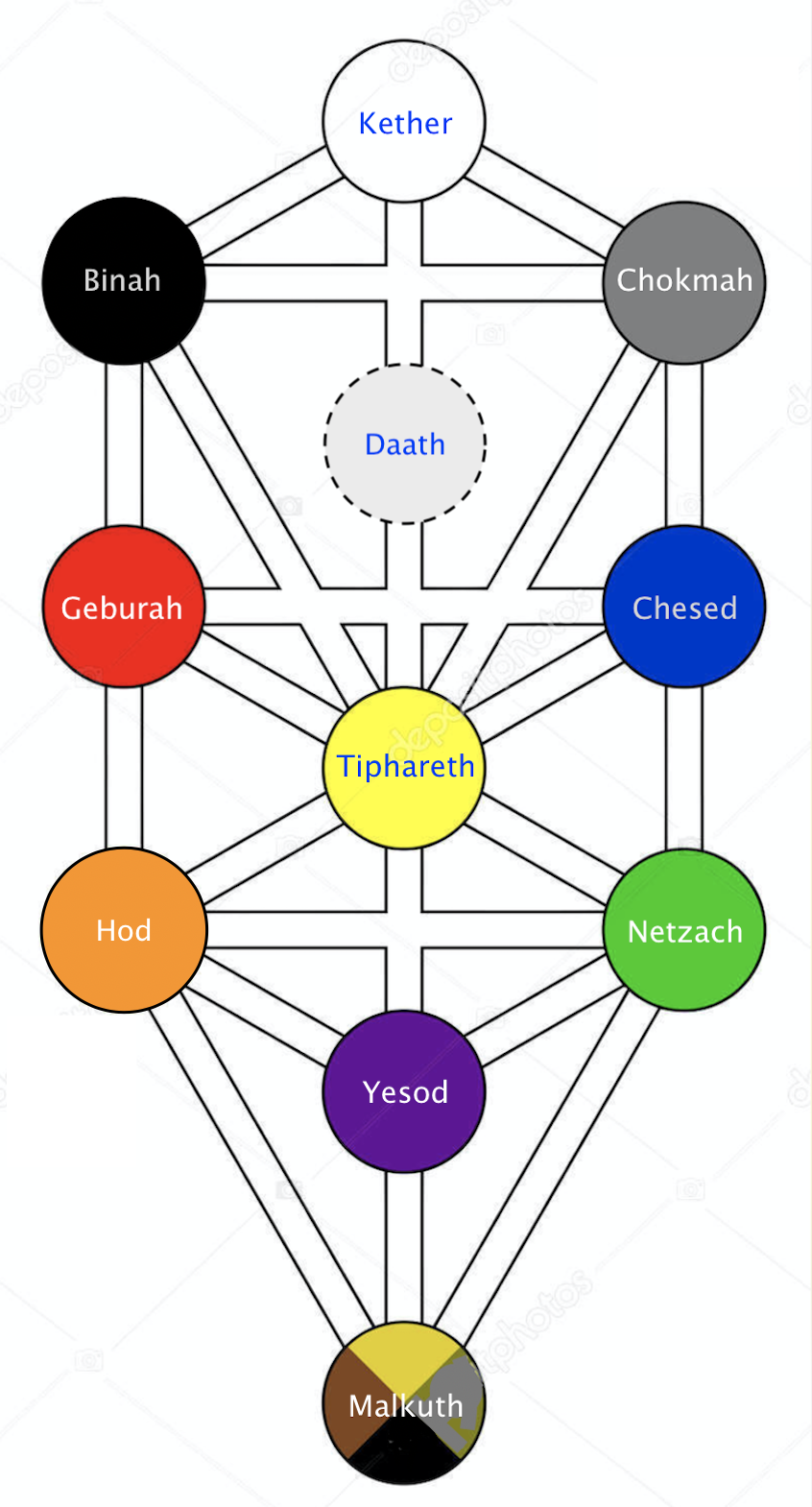
The journey is not a trip into visions of outer realms nor is it about the development of psychic powers. The real journey is the transformation of our being. This lies within us, and is embedded in the world we are already in, and in the experiences of our life right here and now. That we may have so far missed its magic is the real tragedy. Because the path is always there, waiting to be taken.
Each Tree of Life contains ten Sephiroth (plural for Sephirah) or stations which are interconnected as shown in the diagram. There is also a hidden Sephirah, Daath, that forms a bridge between Tiphareth and Kether when it is revealed.
The four Trees of Life, overlapping on top of each other to form Jacob’s Ladder, present a lyrical account of that journey. If we would delve into it deeply, we would come to realize it is a path we already know. It is a path of our internal transformation, a path of struggle, trials and challenges, requiring our total commitment. And it is a path of compassion and wisdom, a path of bliss heading towards the ultimate unity, the purity of oneness.
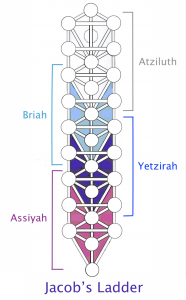
The structure of Jacob’s Ladder is of importance, for in its very design is a profound message, one we need to learn well. To progress along the spiritual path, we climb upwards from one Tree of Life to the next. These four trees are known as the four Worlds of Manifestation. The highest Tree, known as the first World of Manifestation, is Atziluth. The second World is Briah, the third is Yetzirah, and the fourth Assiyah. We start from the fourth Tree, Assiyah, and progress upwards to the first.
The three Trees above Assiyah, where we begin our journey, are characterized by the three Veils of Negative Existence: Ain Soph Aur, Ain Soph, and Ain. We have to unveil each of these to set foot on the corresponding higher Tree of Life. Ain Soph Aur, which means Limitless Light, characterizes the spiritual journey beginning with, and mediated by, the Sephirah, Malkuth, in the Tree of Yetzirah, the beginning of this World of Manifestation (it is the same Sephirah as Tiphareth in Assiyah). Ain Soph, which means Limitless, or the All, characterizes the spiritual journey beginning with, and mediated by, Malkuth in Briah; and Ain, which means No-Thing, characterizes the spiritual journey beginning with Malkuth in Atziluth. These three Veils correspond to the Three Principles of the Path in Tibetan Buddhism. We shall be exploring these in depth, and in the end, it will become evident why they are called the Veils of Negative Existence.
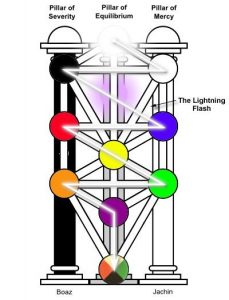 Each Tree of Life has its ten Sephiroth arranged along three vertical pillars: the Pillar of Form or Severity on the left, the Pillar of Force or Mercy on the right, and the Pillar of Consciousness, Mildness, Equilibrium or Balance, in the center. Each pillar is made up of two types of Sephiroth, which alternate with each other as we move upwards.
Each Tree of Life has its ten Sephiroth arranged along three vertical pillars: the Pillar of Form or Severity on the left, the Pillar of Force or Mercy on the right, and the Pillar of Consciousness, Mildness, Equilibrium or Balance, in the center. Each pillar is made up of two types of Sephiroth, which alternate with each other as we move upwards.
On the Pillar of Severity, Hod and Binah (on each Tree of Life) make up one type of Sephirah. Their modern names of “Intellect” and “Substance” are apt descriptions of what they are. These Sephiroth represent our core reference perspective, our intellectual and personal makeup, which guides our attitudes, motivation and actions. It is the foundation of our being which we have to transform on the journey upwards. Essentially it is our task, on each Tree of Life, to transform Hod into Binah. And since Binah is Hod on the next higher Tree of Life, this task then repeats itself at a higher level. The other type of Sephirah on the Pillar of Severity is found in Geburah on each Tree of Life. The modern name of Geburah is “Will.” It is the will as manifested at different levels of attainment.
The Pillar of Mercy is also made up of two different kinds of Sephiroth alternating with each other. Netzach and Chokhmah on each Tree of Life make up one type of Sephirah on the Pillar of Mercy. Their modern names are “Desire” and “Force,” and they represent the driving inspiration for the journey upwards. Chesed on each Tree of Life makes up the other kind of Sephirah. Its modern name is “Memory.” It is our memory as manifested at different spiritual levels. In the lowest Tree, Chesed would, at the deepest level, represent the Buddha nature within us, and, at a practical level, function as our conscience. On the next higher tree, Chesed represents the cosmic memory or Akashic record.
The Pillar of Mildness, in the center, is a pillar of realization. It is also made up of two types of Sephiroth. Malkuth, Tiphareth, and Kether on each Tree of Life form one type of Sephirah on this pillar. They represent conscious states of realization, which is equivalent to the deeper state of mind that may be reached during meditation, although it may also occur outside of meditation under the correct conditions. The other type of Sephirah is found in Yesod, and in the hidden Sephirah, Daath. These are mystical experiences, mental or mystical states of insight and bliss, generally of an increasing intensity at higher and higher levels of attainment.
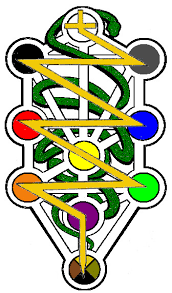
Each Tree of Life has twenty-two paths linking the ten Sephiroth to one another. The Sephiroth are numbered traditionally by the lightning strike and the paths are numbered by the Serpent of Wisdom as shown in the diagram. When we travel up the trees, we do not simply finish up with one path and move on to the next. We do not leave behind any path until it is perfected, so we will generally be working on many paths at the same time. It is more in the nature of a slow drift upwards.
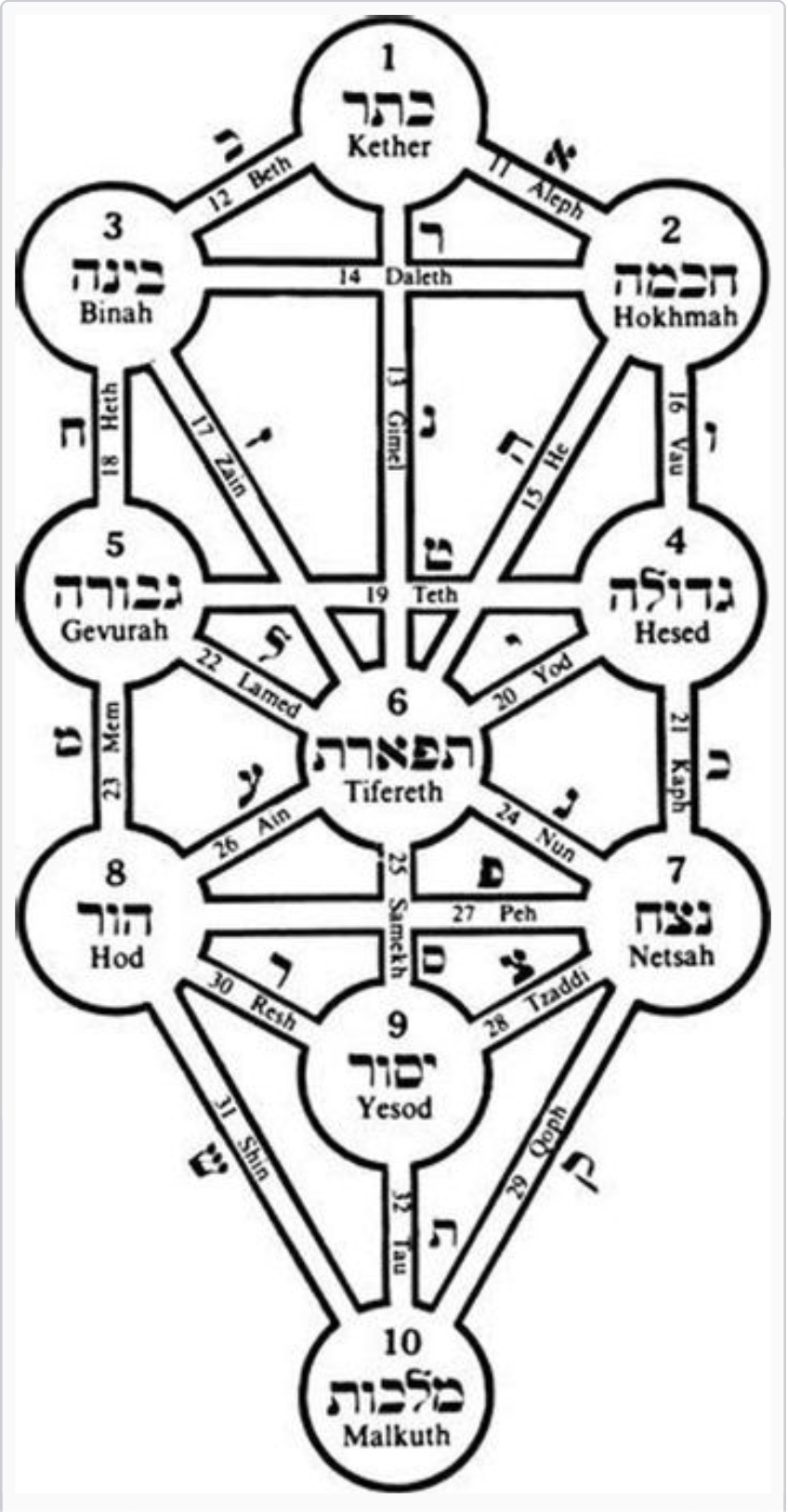
Here, we will be exploring the paths from Malkuth in Assiyah up till Malkuth in Atziluth, since these are the paths described by the supplementary text to the Sefer Yetzirah (which we will refer to as the Yetziratic text), the Hebrew letters, the Three Veils of Negative Existence, the Tarot, the Buddhist Noble Eigthfold Path, the Uttaratantra Shastra, and the Three Principles of the Path. The paths on the lower tree, Assiyah, are each described by the Yetziratic text, and also by the Hebrew letters. The paths on the next higher tree, Yetzirah, are described by the Tarot images of the Greater Arcana. Both the eight paths centered around Tiphareth of each Tree of Life are depicted by the Buddhist Noble Eightfold Path. The higher four horizontal paths in the first two Trees of Life are also given by the Uttaratantra Shastra, together with the means to cross them, depicted by the right diagonal paths leading up to them. And the stages of the path beginning with Malkuth of the three Trees above Assiyah are characterized by the Three Veils of Negative Existence and the Three Principles of the Path.
There is remarkable cohesiveness and consistency in the structure of Jacob’s Ladder despite being described by sources from apparently different traditions. Each of the corresponding paths on the lower two Trees of Life (Assiyah and Yetzirah) are identical in direction and function, despite the fact that one set of paths is described by the Yetziratic text while the other is described by the Tarot. (This means, for example, that the path between Malkuth and Yesod on both the Trees function in the same way and takes the same direction; a feature found in all the corresponding paths on both the Trees.) This is one manifestation of the words “as above, so below”—the paths in the World of Yetzirah function and interact in essentially the same way as the paths in the World of Assiyah.
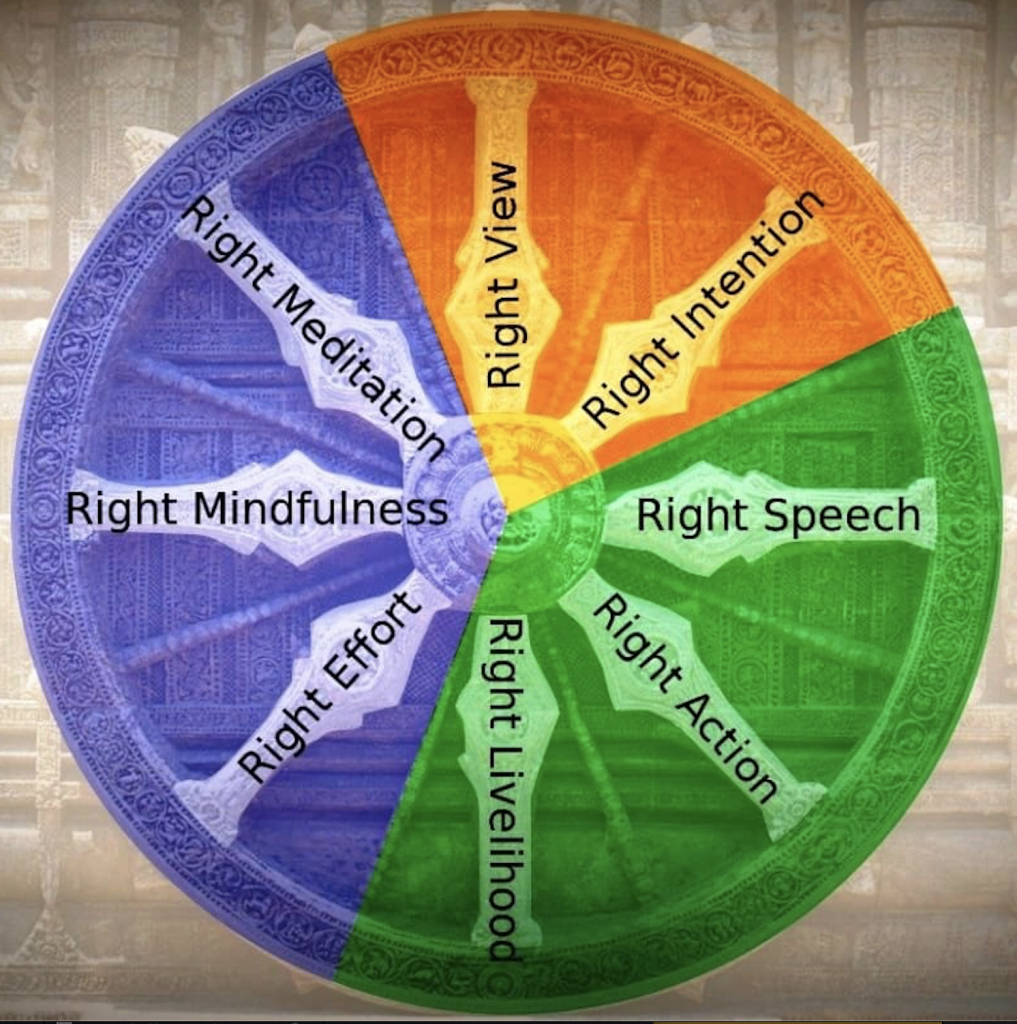
The most remarkable synchronicity between sources from apparently different traditions is the fact that, for both these Trees of Life, the Buddhist Noble Eightfold Path depicts the paths around Tiphareth (like the spokes of a wheel) in exactly the correct clockwise sequence. Also, the Uttaratantra Shastra agrees with both the Yetziratic text and the Tarot with regards to the sequential order of the horizontal paths on these two Trees of Life. And, finally, all these agree with the corresponding names of the Three Veils of Negative Existence and the Three Principles of the Path in Tibetan Buddhism.
The horizontal paths on Jacob’s Ladder are of particular importance. Each represents a barrier, a threshold, which has to be crossed before we can proceed. They are like the blindfolds we must remove for a vision of the radiant skies ahead, the boulders we must climb to view the unfolding horizons. For until we transcend these barriers, we will not be able to see our way to proceed.
These horizontal paths are all in the nature of aspirations, commitments which have to be made before the higher paths will open to us. Like the Sephiroth on each Pillar, the horizontal paths or thresholds are also of two types. The paths linking Chesed with Geburah, on all the Trees, form one type, and the paths linking Netzach and Hod, or Chokmah and Binah, form the other. Both of these function together with Tiphareth in a very distinctive way:
When we open the corresponding Veil of Negative Existence, we reach Tiphareth (which is Malkuth of the next higher Tree of Life). Then to actually start journeying up this next higher Tree, we have to overcome the two barriers represented by the two horizontal paths above Tiphareth. This process (of overcoming these barriers) is mediated by Tiphareth; hence Tiphareth is known, in the Yetziratic text, as the Mediating Intelligence.
The first barrier, the path between Chesed and Geburah, is worked through many times. We travel a route from Tiphareth to Chesed, then from Chesed to Geburah, and then from Geburah back to Tiphareth. This forms a circuitous path which we have to take again and again, each time building up on the realization of Tiphareth. Hence the barrier between Chesed and Geburah does not represent a threshold to be crossed only once. It represents, in fact, many thresholds that we have to cross each time we reach it. The circuitous route, which repeatedly crosses this threshold, is the engine room that will fuel us up the spiritual path.
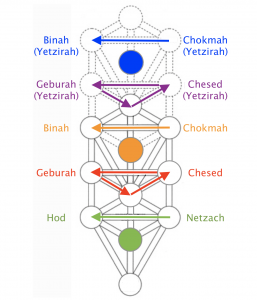
When Tiphareth is sufficiently built up, we encounter the next threshold, that between Binah and Chokmah. And this is a crucial threshold, for it absolutely defines whether we stop here or we go on. This threshold is of the nature of a surrender or sacrifice, a relinquishing of a part of our personality that keeps us separate from the All. The Hebrew letter assigned to this path means door, and it is the real door to the higher Tree of Life. We cannot proceed unless we open this door, for only then do we see the hidden Sephirah, Daath, which will then reveal itself as Yesod of the next higher Tree of Life.
Without this Sephirah, we cannot possibly reach Kether, for it is the bridge across the chasm, the oasis allowing passage across a formidable desert. When revealed as Yesod, it represents a state of higher realization and a state of bliss, of increasing intensity at each higher Tree of Life it appears. Each provides the essential nourishment to propel us into the next higher World of Manifestation. They are mystical experiences providing the flame that lights up the path ahead, the inspirational fire for the precipitous climb towards the pristine skies of our spiritual destiny.
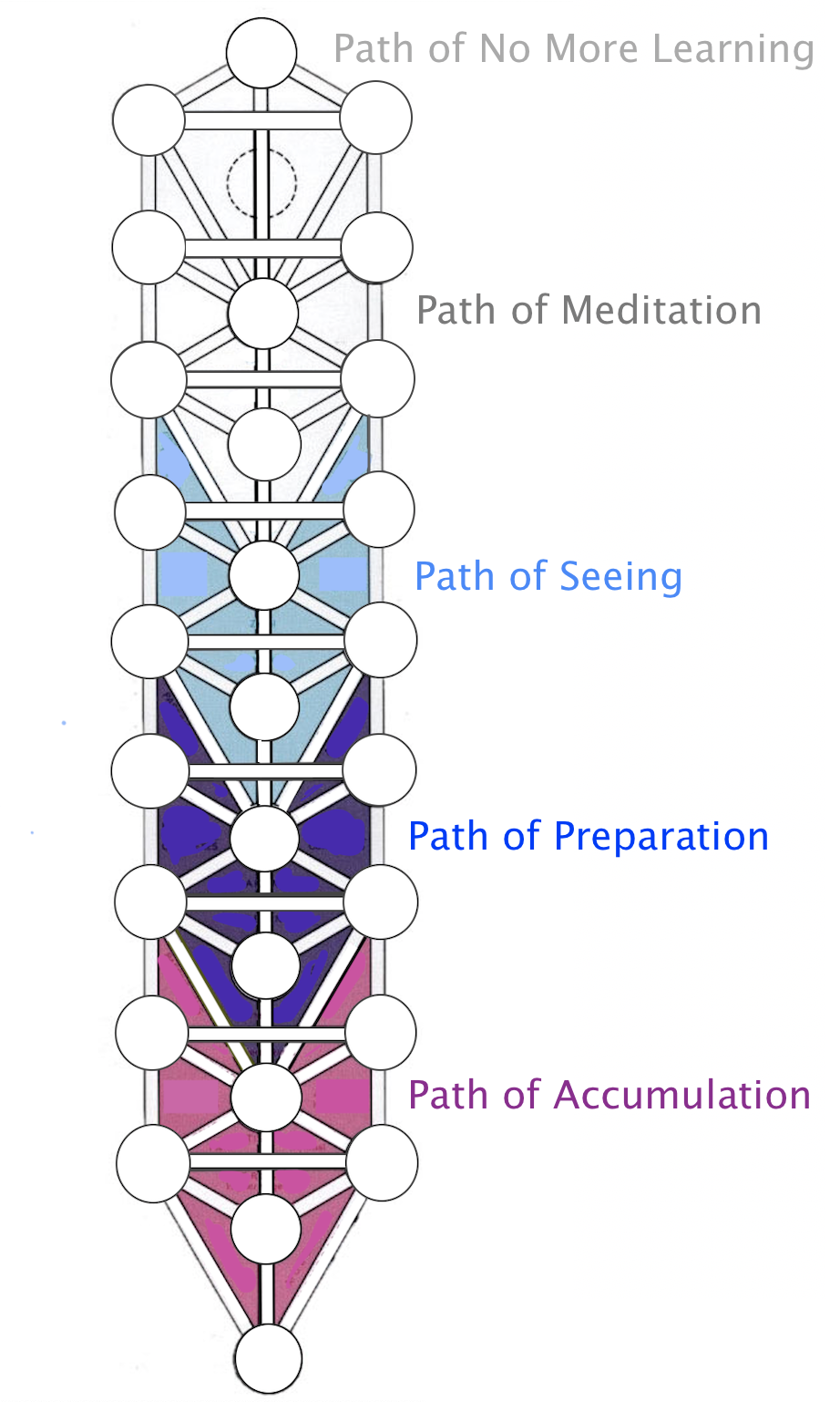
Jacob’s Ladder has five pairs of these Sephiroth comprising of Yesod and Tiphareth (or the revealed Daath and Kether, which are Yesod and Tiphareth of the higher World of Manifestation). Yesod represents the mystical experience that enables us to reach the more stable spiritual state of Tiphareth which then needs to be refined further until we are ready to cross the next threshold in order to proceed to the higher Yesod of the next World of Manifestation. These sets of Yesod and Tiphareth (or the revealed Daath and Kether) form stages of the spiritual path which become more profound and intense the higher we go. These stages correspond to the stages depicted as the “Five Paths” known in Vajrayana Buddhism as the Path of Accumulation, the Path of Preparation, the Path of Seeing, the Path of Meditation, and the Path of No More Learning. Each of these stages in the Spiritual Path can only be reached after we cross its corresponding threshold.
The spiritual path is thus a path with many thresholds to be crossed, one after another. When we reach each threshold, or when we realize each next step we have to take, we simply have to make the commitment and go. This is really the Kalama Sutta in action. We must act on what we know. We must cross each threshold when we come to it. Otherwise, we go no further; that is where we stop. This then is the crucial message unmistakably staring at us from the structure of Jacob’s Ladder.
The spiritual path is a path of aspiration, of determination to always take the next step, of the will to overcome all challenges hurled at us. It requires total commitment, for the barriers may be formidable, and the temptations to stray most enticing. It is a long arduous journey, a steep climb to the stars. Yet it is also one of sheer joy, of magical bliss and ecstasy at times so intense it becomes unbearable. But most importantly, it is a path of compassion, a journey to save each and every being from the folly of remaining in a vicious cycle of suffering.
Copyright © 2021 by Kenneth K C Chan. All Rights Reserved.